Greve represents the northern gateway to the Chianti, the first stop from Florence. The SS222, known as the Chiantigiana, or Chianti Way, winds its picturesque way from Florence to Siena, through this peaceful region, offering archetypal scenes of cypress trees, olive groves and vineyards. At first sight, Greve may be a disappointment: it seems a slightly characterless, modern-looking town. Luckily, its main square is a redeeming feature, as are its restaurants, food and wine shops. The impressively arcaded Piazza Matteotti is surmounted by wrought-iron balconies of cascading geraniums. The shops under the arcades are crammed with an assortment of Tuscan treats, crafts and wines. The square is framed by a neo-Renaissance Town Hall. Above all, as Chianti’s commercial hub, Greve does the business, with its weekly market, September wine fair and a tempting wine route beginning outside town. Greve is a stepping-stone to Renaissance villas, castles, abbeys and wine estates.
This article was crafted by To Tuscany to ensure our guests enjoy the best possible experience during their time in Tuscany. Explore our villas in Greve in Chianti.
Or contact our Villa Specialist team, who are available to assist you. Click here to get in touch.
Greve in Chianti
-
-
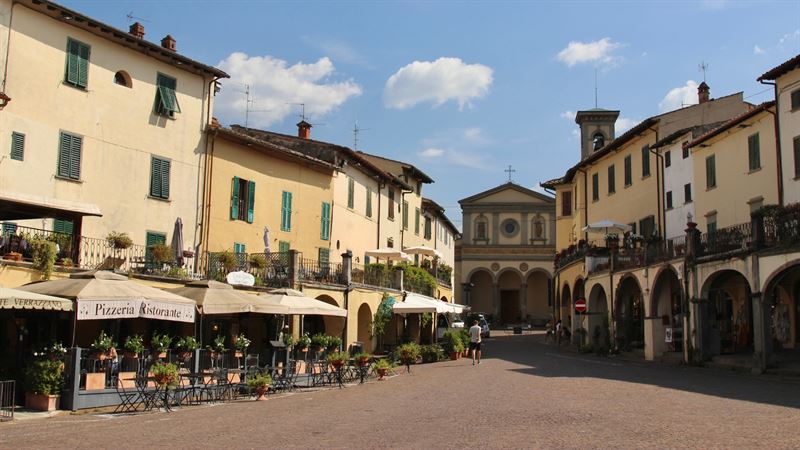
Top Ten Things to Do
Greve, the commercial centre of Florentine Chianti, is a place for browsing for wine and foodstuffs. While there is little of cultural interest in town, the surrounding countryside makes for delightful pottering. From Greve, enjoy gentle hikes, along with scenic drives to neighbouring castles and medieval wine estates. Greve also makes a great base for cultural day trips to Siena and Florence, along with Chianti-based wine-tasting and foodie forays in the vineyards.
-
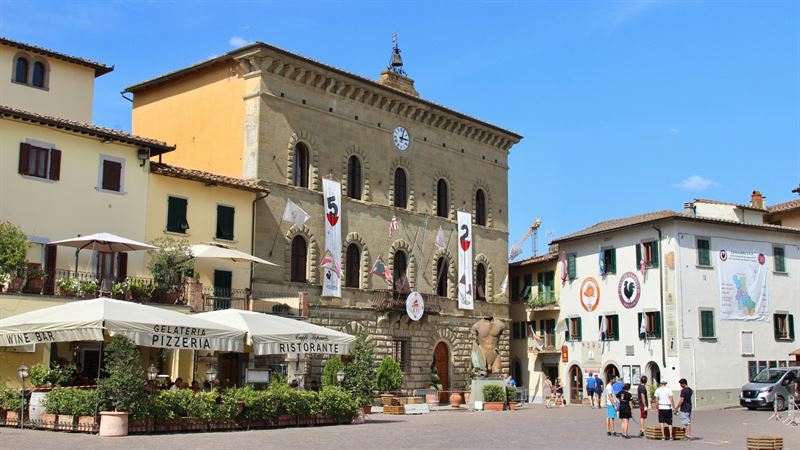
1. Take in Piazza Matteotti
Although Greve is an unremarkable market town, its main square commands attention. The porticoed Piazza Matteotti is a lovely place for taking in the bustling atmosphere. Browse the market, potter under the porticoes in search of Tuscan treats. Call into Bistrot Falorni for Tuscan fast food, a tasty taglieri, a Pecorino cheeseboard or a plate of hand-cured meats, along with a welcome glass of Chianti Classico. If you can tear yourself away from lunch, glance at the neo-Renaissance Town Hall, the Palazzo del Comune, and the parish church of Santa Croce, with its neo-classical facade. The church is a reminder that Greve flourished at the meeting place of several pilgrimage routes.
If time, call into the small Wine Museum. These ancient wine cellars hosted the predecessors to the slick the Chianti Classico consortium. Back in 1906 it was called the Chianti Wine Union and was restricted to local aristocratic landowners. After looking at the displays of old tools, farm machinery and corkscrews, tuck into a wine-tasting, which is included in the ticket price. The museum’s revamp is thanks to the Bencista Falorni family who own these cellars.
Before venturing forth on a wine trail, admire the monument to the great explorer Giovanni da Verrazzano (1885-1528), who explored the North American coast. If exploring is on your mind, consider the short drive to the explorer’s castle, Castello di Verrazzano, just north of Greve. Ponder a short hike to Montefioralle, one of the prettiest stone-built villages close to Greve. Or ponder discovering some of the Chianti’s finest vineyards, which lie just outside town. Badia di Passignano, a former monastic estate, makes a good start, especially as it is a shrine to Antinori wines.Greve can also be an amusing spot for people-watching. Set around 30 km south of Florence, the town has long been popular with the Chiantishire set, given its sought-after wine and oil estates and charming farmhouses. Unlike more remote parts of Tuscan countryside, the Chianti has not suffered from depopulation. The influx of the wealthy, olive-nibbling classes has helped maintain the positive trend, with tumbledown farmhouses snapped up by the Chiantishire crowd.
Address: Greve Wine Museum, Piazza Tirinnanzi 10, 50022 Greve
Web: http://www.museovino.it/ -
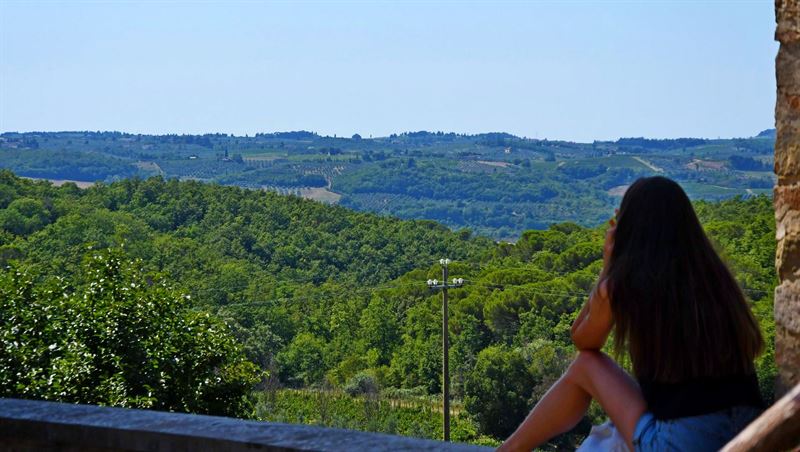
2. Greve walk to Montefioralle
Perched on a hill just outside Greve is medieval Montefioralle, a tiny, walled `borgo.’ This hidden gem is just five minutes’ drive west of Greve but can also make a delightful walk. From Greve, it’s a short, steep but rewarding 2km hike ending in wonderful views. Start in via di San Francesco off via Roma. The winding route leads to the walled settlement, once the feudal castle. Although no longer a military outpost, Montefioralle is still fortified. The walls were once octagonal, bounded by four gates, parts of which survive.
Following the tides of Tuscan history, the village has belonged to the Ricasoli, Benci, Gherardini and Vespucci families. The village was the birthplace of Amerigo Vespucci (1415-1512), who followed Columbus’ route to America. The explorer’s ancestral home lies along the main street, and is indicated by his coat of arms, incorporating a wasp. Wander along narrow alleys and secret passageways past well-preserved stone-built houses. The village is surmounted by the church of Santo Stefano but panoramic views also await in the local inns. Unless you’ve brought a picnic from Greve, opt for lunch in a local inn, such as the romantic La Castellana or the simpler La Taverna del Guerrino. La Taverna is a Slow Food inn but looks rather like a “hole-in-the-wall’ place, despite being blessed with a panoramic terrace. Typical dishes include Tuscan grills (cooked on a wood-fired grill) and pasta dishes. The best seasonal pasta dishes are tagliatelle al cinghiale (with wild boar), tagliatelle al tartufo fresco (with fresh truffles) and tagliatelle ai funghi porcini freschi (with fresh ceps).
Address: La Taverna del Guerrino, via di Montefioralle Centro 39, Localita Montefioralle, 50022 Greve in Chianti
Tel: 055 853106
Web: www.tavernadelguerrino.it -
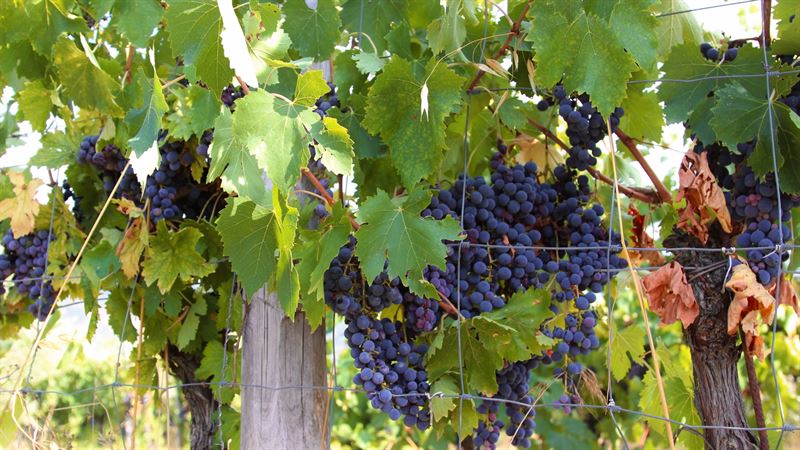
3. Wine-making experience at Fattoria Viticcio
In Fattoria Viticcio, a local wine estate, you can dream the winemaker’s dream. Unusually, you can also pretend to be a Tuscan winemaker for a while. This behind-the-scenes blending experience can be comfortably fitted into a morning or afternoon. The session allows you to blend your own wine and even take home a bottle of your personal wine. The process involves a guided tour and tasting, including sampling wine direct from the barrels. The estate lies only 2 km outside Greve in Chianti so makes for an easy walk through the vineyards to town. There’s no excuse for not indulging in a leisurely tasting. What’s more, as this is a family-run winery, the mood is more hands-on than at grander Tuscan estates.
The alternative experience is a winery visit and guided tasting of four wines (three Chianti Classico and one Super Tuscan, also known as an IGT). The wines are paired with Viticcio Extra Virgin Olive Oil and Tuscan salami and cheeses from the celebrated L’Antica Macelleria Falorni butcher’s in Greve. The estate produces not just Chianti Classico wines, along with Vin Santo and Grappa, but also wines from Bolgheri and Maremma vineyards, including full-bodied Morellino di Scansano. Their 60 hectares of vineyards encompass classic Chianti Sangiovese grapes, as well as Cabernet Sauvignon, Cabernet Franc, Merlot, Syrah, and Vermentino.
Address: Via San Cresci 12/A, 50020 Greve in Chianti
Tel: 055 854210
Web: www.fattoriaviticcio.com -
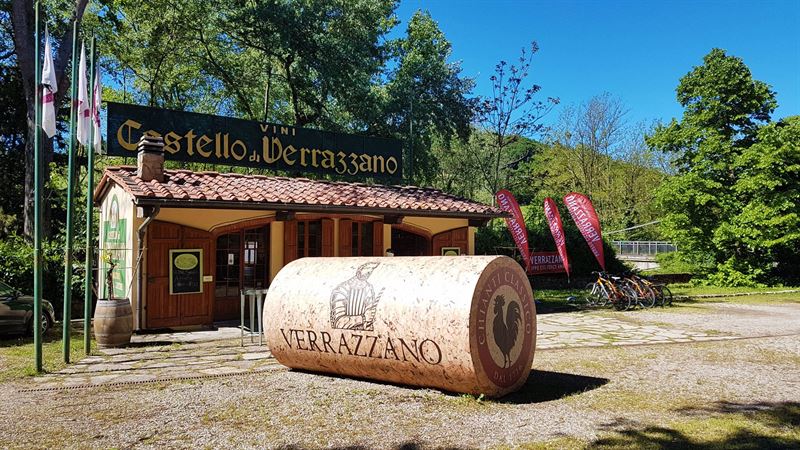
4. Castello di Verrazzano - explorer’s castle and wine estate
Crowning a hill 3 km north of Greve, this castle was the birthplace of explorer Giovanni da Verrazzano (1485-1528) who discovered the Bay of New York. His feat is commemorated in the Verrazano Narrows Bridge in New York, between Brooklyn and Staten Island (an `r’ was lost mid-Atlantic). Verrazzano’s log books go further, recording the first-known descriptions of the Hudson River, the Bay of New York and large part of east coast America. The explorer’s efforts on behalf of King Francis I were rewarded with great honours, including the right to put the French fleur de lys on the family crest. This great Tuscan seafaring family included map-makers and admirals among its number before dying out in 1819.
Today, Castello di Verrazzano is best-known for its renowned wine cellars and wine museum. The estate produces high quality Chianti Classico wines, along with olive oil, honey and balsamic vinegar. The castle was saved from near ruin by the present owner, Cavaliere Luigi Cappellini, who has restored it to its ancient splendour. Concerts are sometimes held on the magnificent roofed terrace, and wine tours take place in the castle’s 16th-century cellars.
The estate offers a range of different tours, from garden tours and gourmet lunches to food and wine experiences and straightforward wine-tastings. The rustic-elegant restaurant, L’Hosteria della Cantina, specialises in wild boar dishes and straightforward, seasonal Tuscan cuisine, including tasting menus and wine-pairing. On the menu are grills, T-bone steak and pasta with meaty ragu sauce or local herbs. All the produce is Tuscan and often organic from the estate vegetable gardens, A range of menus caters to everyone from foodies to vegetarians and small children.
Address: Via Citile 32, Località Greti, 50022 Greve in Chianti
Tel: 055 854243
Web: www.verrazzano.com -
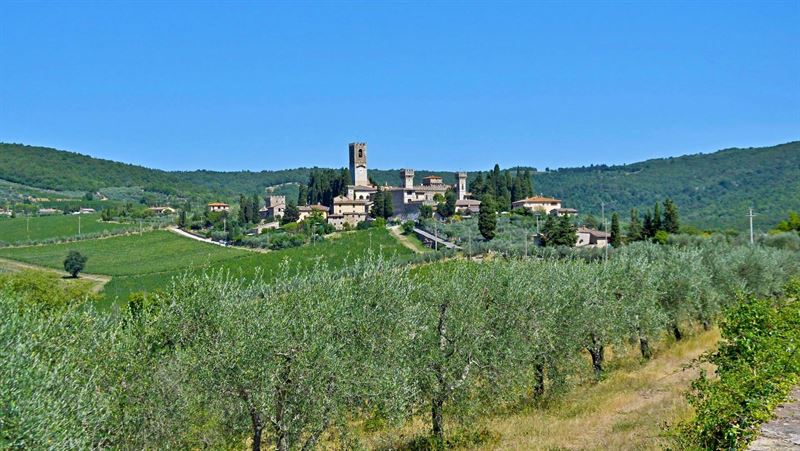
5. Badia di Passignano - medieval abbey & Antinori wine estate
Just west of Greve is a moody hamlet centred on a Benedictine monastery. Badia di Passignano was founded by the Vallambrosan order in 1049. All around are vineyards belonging to the Antinori Chianti estates. This particular Antinori wine estate is given over to vineyards of Sangiovese grapes and olive groves. This Florentine-based wine dynasty have been peddling the `nectar of the gods’ in Tuscany since 1385. Before succumbing to the wine option, spend a bit of time in the fortified abbey where the great Galileo Galilei taught in the 16th century. Pre-book a guided tour with one of the handful of remaining Vallambrosan monks to admire a refectory decorated with a magnificently restored Last Supper by Domenico Ghirlandaio.
If more earthly concerns are on your mind, then the abbey can also sustain you. The Antinori’s Michelin-starred restaurant occupies part of the vaulted abbey, with the so-called `historical cellars’ located immediately below the abbey. At the estate you can sample Antinori signature wines, whether Chianti Classico wines or Super Tuscans. Famous names are Tignanello, Guado al Tasso, and Solaia, as well as Chianti Classico Riserva Badia a Passignano. Book an Antinori wine-tasting and cellar tour, possibly even an oil-tasting, followed by lunch or dinner in their onsite fine-dining restaurant. L’Osteria di Passignano or their far simpler Trattoria della Fonte in a farmhouse nearby. Instead, L’Antica Scuderia is the best dining option for families or anyone fancying a pizza.
Address: Badia di Passignano, Localita Badia a Passignano, 50028 Tavernelle Val di Pesa
Tel: 055 8072341
Web: www.osteriadipassignano.com -
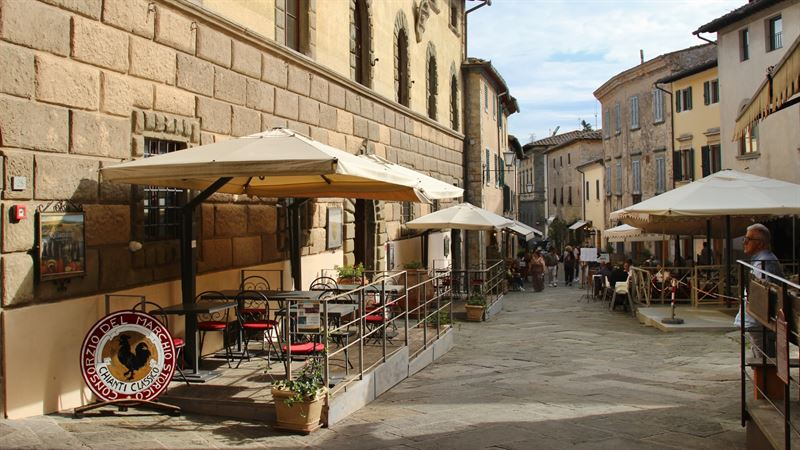
6. Castellina in Chianti for a foodie foray
Visit neighbouring Castellina in Chianti, a charming town south of Panzano. Wander down via delle Volte, a quaint stone-vaulted street built into the side of the hill. Devour delicious ice cream at Gelateria Castellina, known for its experimental ices. The flavours range from ricotta and fig to chilli and chocolate or lemon and kiwi fruit. There’s also the owner’s favourite creation, cantuccini and Vin Santo: almond biscuits with sweet Tuscan wine. There’s no escaping wine in the Chianti.
Consider your first wine-tasting as Castellina is awash with Chianti Classico. The trademark on bottles of Chianti Classico is the Black Rooster (or Black Cockerel), the historic symbol of the Chianti Military League. In the late 13th century, Castellina was the first site of the Chianti League, a group of three Florentine feudal castles. Call into L’Antica Trattoria alla Torre for lunch. Set on the main square, this old-fashioned inn serves Tuscan treats on a summery terrace. Tuck into the Florentine T-bone steak, grilled meats and Pecorino cheeses, all washed down with Chianti Classico wines.
Go shopping for Tuscan foodstuffs, including cheeses, biscuits, cured meats and pastries. (For shopping suggestions, see our guide to Castellina in Chianti).
Gelateria Castellina, Via IV Novembre 47, 53011 Castellina in Chianti
T: 0577 741337 & www.anticadelizia.it
Address: L’Antica Trattoria alla Torre, Piazza del Comune 15, 53011 Castellina in Chianti
Tel: 0577 740236
Web: www.anticatrattorialatorre.com -
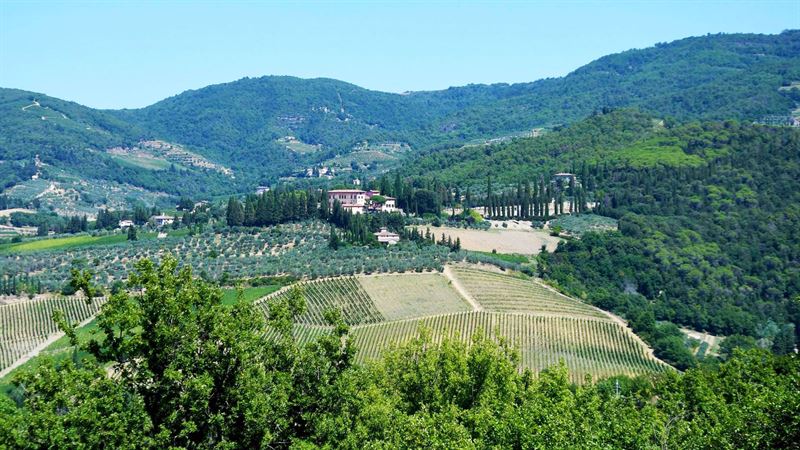
7. Vignamaggio – Renaissance villa estate and gardens
This Renaissance villa estate is linked to great art. Set 5 km southeast of Greve, the wine estate is delightful enough to have starred as a film set, based on Shakespeare’s Much Ado About Nothing.
The romantic villa lords over its Italianate gardens and vine-clad hills. The serene landscape supposedly inspired Leonardo da Vinci. The castle was remodelled as a patrician villa in the 14th century and belonged to the Florentine Gherardini family. Monna Lisa Gheradini, better-known as Leonardo da Vinci’s Mona Lisa, married into this family in the 14th century. The villa boasts a crenellated tower, 16th-century corbelled arches and courtyard, with the top of the tower remodelled in Neo-Gothic style.
Centred on the lovely Renaissance villa, this tenuta is an established 65-hectare wine estate, and one of the oldest in Tuscany, dating back to 1404. The award-winning wines range from Chianti Classico and trendy Super Tuscans to a fresh Rosé, a Cabernet Franc, Vin Santo and grappa. Orchards, herb gardens, wheat-fields and thirty hectares of olive groves reflect the estate’s commitment to biodiversity. The villa grounds showcase Italianate, Renaissance-style gardens, complete with cypresses, clipped box parterres and rose-draped statuary. French owner and architect Patrice Taravella has recently spruced up the grounds, adding orchards, classical pool fountains and pergolas.
Vignamaggio now offers garden and cellar tours, as well as a free wine-tasting. The farm-to-table Ristorante Monna Lisa means much of the produce comes from the surrounding organic estate. Wine-pairing lunches are on offer, as are guided tours of the estate, ending in a sunset dinner. The seasonal menu celebrates Tuscan produce, from vegetable platters drizzled in home-produced olive oil to pasta with pistachio and garden-mint pesto. The pork and cured meats come from the estate's happy herd of cinta senese pigs.
Address: Via Petriolo 5, 50022 Greve in Chianti
Tel: 055 854661
Web: www.vignamaggio.com -
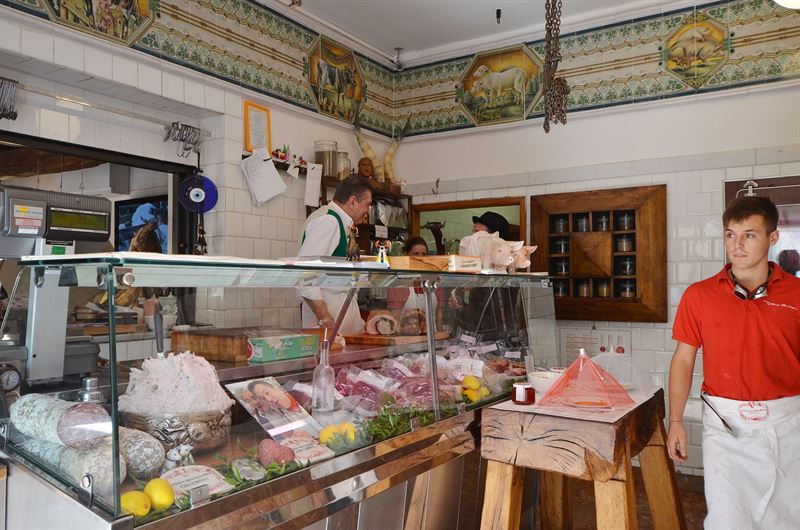
8. Indulge in a meat fest in Panzano
Panzano, just south of Greve, is the place to indulge in a passion for Tuscan meat, including Florentine T-bone steak. This Tuscan bastion is the meaty preserve of Dario Cecchini, a cleverly eccentric celebrity butcher with a mini empire in these parts. No one can wield a bloody meat cleaver better, still less while reciting Dante. Part butcher, part showman, Dario keeps his audience entertained as well as over-fed.
With several restaurants in town, all clustered round his famous butcher’s, Cecchini is still doing a brisk trade. The restaurants are fairly priced so there’s no sense of being caught in a tourist trap. The winning format appeals to most visitors, as does the conviviality and showbiz side.
T-bone steak predominates, at least in one restaurant. For any beef-loving Tuscan, bistecca alla fiorentina – a huge, tender T-bone steak, grilled over an open fire and seasoned with nothing more than crushed pepper¬corns, salt, and a hint of garlic and olive oil, served very rare – is the ultimate steak. Bear in mind that all is not bleak for vegetarians: there are strong meat-free menus for those of a more squeamish disposition. Basic wine is included in the price but you can also bring your own.
Address: Via XX Luglio, 11, 50022 Panzano In Chianti (Fi)
Tel: 055 852020
Web: www.dariocecchini.com -
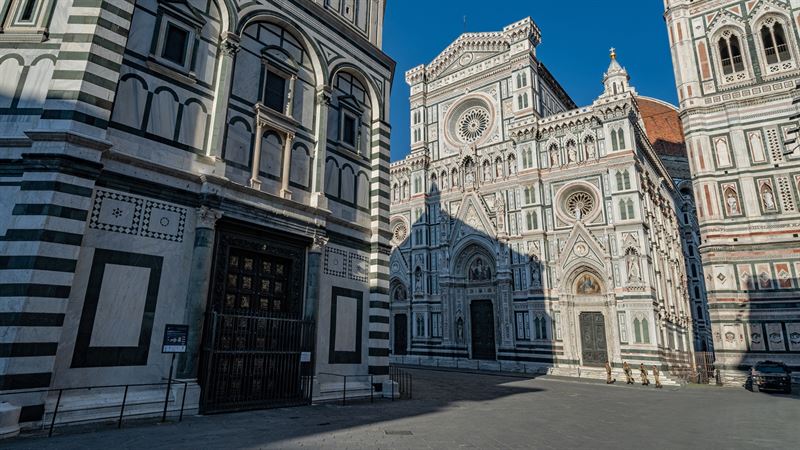
9. Art-filled Florence
Florence lies just 30 km north of Greve in Chianti. Despite devouring the checklist of must-see sights, steer clear of suffocating under the weight of treasures. Allow time for aimless wandering. Beyond the selfie sticks and statuary awaits a funky foodie haunt with sleek cafes, superb cooking and seriously edible markets. Florence is not fusty. Nor has the greedy city lost its gutsy Tuscan soul: traditional inns still serve earthy peasant fare, including macho steaks. Beware of trying to do too much on a day trip. Balance visits to galleries with wanderings in search of the perfect trattoria or the perfect view.
Begin in Piazza della Signoria, the city’s grandest square, with its copy of Michelangelo’s David and, beside it, the crenellated Palazzo Vecchio, with a well-presented collection. After a coffee at Rivoire, brace yourself for the Uffizi Gallery, the world’s greatest collection of Italian art. As such, the gallery is both a feast for the senses and an indigestible banquet so try and plan your visit in advance or even book a time slot online. After lunch, visit the Duomo, the biggest building for miles around. It is still Brunelleschi’s Renaissance dome that defines Florence. Out of respect for Brunelleschi’s achievement, the city forbade the construction of any building taller than the Duomo.
Clear your head in the Oltrarno, across the river Arno, where the Giardino Boboli (Boboli Gardens) act as an excellent antidote to the suffocating splendours of the Pitti Palace. The Medici dynasty created these statuary-encrusted gardens, which became the model for Italianate gardens for centuries to come. Before dinner, explore the Oltrarno neighbourhood's craft heritage on the so-called Left Bank of the city. This bohemian district is studded with stylish bars and buzzy inns interspersed with antique shops, jewellery-makers, picture-restorers and bijou art galleries.
Check our Florence guide to see what appeals most. If visiting a number of museums, consider buying a Firenze Card online (www.firenzecard.it) and also book a time slot at the Uffizi Gallery. -
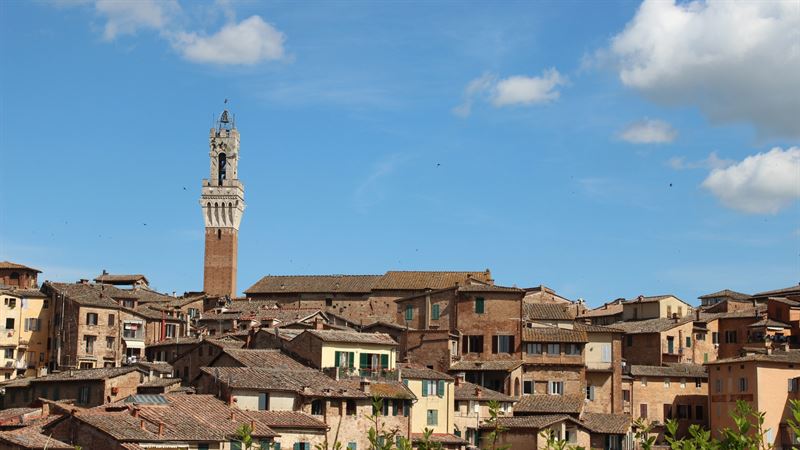
10. Day trip to Siena
Siena frames the southern end of the Chianti and makes for a magical day trip. Set around 40 km south of Greve, Siena is a Gothic city built on a human scale and is effortlessly civilised and at ease with itself. All roads lead to Il Campo, the beguiling, shell-like central square, shaped like an amphitheatre. Sit at a terraced café on the sloping side of the square and spot the division of the paved surface into nine segments, recording the wise Council of Nine who governed Siena from the mid-13th century to the early 14th. Consider climbing the slender Torre del Mangia, with sultry views over a pink piazza and Siena’s rooftops, even if the views from the Cathedral rooftops are even better.
After an early lunch, a leisurely stroll leads to the Duomo, Siena’s pinnacled Gothic cathedral. The facade is a riot of green, pink and white marble, like a glorious iced cake. Siena Cathedral and the Cathedral Museum should be seen as one entity as they share several spaces. The Museum displays Pisano’s original statues for the façade along with Siena’s best-loved work, Duccio’s Maestà, the Virgin Enthroned. For many visitors, equally impressive is the rooftop walk, known as the Panorama from the Unfinished Façade. These are arguably the finest views of Siena. Facing the cathedral is the Spedale di Santa Maria della Scala, the most extraordinary building in Siena. It began as a hospital a thousand years ago and continued as one until it was reborn as a magnificent museum in recent years. In medieval times, it was always far more than a hospital. The art-studded complex embraces a former pilgrims’ hostel, an orphanage, frescoed churches and granaries.
Don’t let Siena’s art-studded museums blind you to the beauty of the backstreets. Here, the city history unfurls like a medieval banner. Walkable Siena has well-preserved walls and inviting gateways. Wind through a tangle of medieval streets and stumble across secret courtyards, fountains and surprisingly rural views. Check our Siena guide to see what appeals most.
Address: Siena tourist office,
Spedale di Santa Maria della Scala,
Piazza Duomo
Tel: 0577 280551
Web: www.terresiena.it -

Eating & Drinking
The September wine fairs bring the professional wine-tasting crowd to Greve. The surrounding hills are blanketed with vineyards, many of which date back to the time of the medieval monks. Chianti Classico is big business in Greve and has been for centuries. In 1716 Cosimo III, Grand Duke of Tuscany, officially delimited the production zone of Chianti wine. Chianti Classico is made from Sangiovese grapes, or a Sangiovese blend, and aged for 14 months in French oak barrels followed by at least seven months in the bottle, or two years for a Riserva. Our recommended wine estates are featured in each of the individual Chianti guides.
Although this is Florentine Chianti, Sienese-style dishes (or produce such as cinta senese cold cuts) appear on the menu too. As elsewhere in Tuscany, the cooking is never elaborate or excessive; there are no fussy finishing touches, complex reductions of sauces or subtly blended flavours. But there is a basic earthiness about the dishes which has made them popular the world over.
-
Il Bistro Falorni
Set on Greve’s main square, this unpretentious place makes a good stop for a lunch on the run, complete with a glass of Chianti Classico. In the Chianti, fast food means chickpea soup, tasty taglieri, cheeseboards or plates of cured meats, as well as bruschetta slathered with liver paté, and Prosciutto and Pecorino-stuffed panini. Falorni boasts of being a `butcher’s bistrot,’ a café and gourmet delicatessen linked to the town’s renowned local butcher.
Address: Piazza Matteotti 71, 50022 Greve in Chianti
Tel: 055 853029
Web: www.falorni.it -
La Castellana
This small, romantic, family-run inn serves robust, mid-priced Tuscan dishes and a full range of Chianti wines. Local favourites include crostini with chicken-liver paté, grilled meats and beef stew. Specialities include the truffle and mushroom dishes, including tagliatelle or bruschetta with truffles. Lap up the views from the hillside terrace, featuring swaying cypresses, silvery olive groves and endless vineyards. It’s best to book, especially for the terrace.
Address: Via di Montefioralle, Localita Montefioralle, 50022 Greve in Chianti
Tel: 055 853134
Web: www.ristorante-lacastellana.it -
L’Antica Scuderia
Just west of Greve is Badia a Passignano, with its Benedictine abbey and Antinori wine estate. Foodies are spoilt for choice with options. If you resist the Michelin-starred Antinori gastrodome, then try this elegant, summery spot with a terrace overlooking the vineyards. The restaurant occupies a former staging post and stabling for passing knights. The cooking is modern Tuscan, including such dishes as Tuscan crostini, lamb with stuffed artichokes, or game in the form of hare, pheasants and wild boar. Grilled meat is very much on the menu, including T-bone steak. Prices range from medium to high, also depending on the wine selection. Good, inexpensive pizzas are also on offer in this child-friendly spot.
Address: Via di Passignano 17, Localita Badia a Passignano, 50028 Tavernelle Val di Pesa
Tel: 055 8071623
Web: www.ristorolanticascuderia.it -
La Cantinetta di Rignana
Set 4 km from Badia a Passignano, this rural spot is well worth the effort of reaching it. The dreamy setting encompasses an old-world mill and vine-clad hills. This is mid-priced, rustic cuisine, from the tagliatelle with grated truffles to the wild boar stew or the rabbit stuffed with truffled pork. To finish, there’s Pecorino with pear or panna cotta with berries. The wine list ranges from Super Tuscans to La Cantinetta’s own estate wine. Beware that the restaurant lies at the end of a windy, bumpy road.
Address: Localita di Rignana 13, 50022 Greve in Chianti
Tel: 055 852601
Web: www.lacantinettadirignana.com -
La Trattoria della Fonte
Just north of Badia a Passignano, this informal, Antinori-owned inn complements the wine dynasty’s neighbouring fine-dining restaurant, L’Osteria di Passignano. Here, the mood is informal, with the solid Tuscan, mid-priced menu matching the rural setting. Typical dishes include Pienza cheeses, Tuscan cured meats, Florentine T-bone steak and typical crostini. That said, the accompanying Antinori wines can be as modest or magnificent as wished. If you’ve fallen in love with the setting, then ponder an on-site cookery class.
Address: Via Santa Maria Macerata 41, Montefiridolfo, 50026 San Casciano in Val di Pesa
Tel: 055 8244700 / 055 8244743
Web: http://www.osteriadipassignano.com -
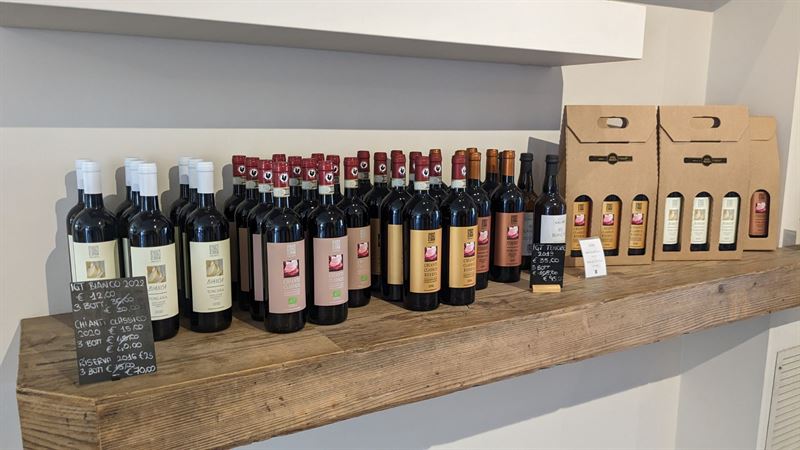
Shopping
Shopping is a pleasurable experience in Greve, especially for Chianti foodstuffs. The Saturday market in Greve is lined with stalls selling everything from fresh fruit and vegetables to cheese, olives, cured meats, flowers, fashion, hand-woven baskets and objects carved out of olive wood. The best foodie emporium is Antica Macelleria Falorni, adjoining Il Bistro Falorni (`the butcher’s bistrot’). As for wine-tasting, the most beguiling spot is L’Enoteca Falorni. Yes, the same family butchers really do have their finger in every meat pie.
-
L’Antica Macelleria Falorni
Founded in 1806, this old-world macelleria (butcher’s shop) is a homely spot. Call by to pick up tasty picnic provisions, including cinta senese, a prized Sienese cured meat, or finocchiana briciolana, pork salami made with fennel seeds and Chianti wine. If you’re tempted to stay for a bite, then call into the adjoining Il Bistro Falorni, the `butcher’s bistrot,’ café and gourmet delicatessen.
Address: Piazza Matteotti 71, 50022 Greve in Chianti
Tel: 055 853029
Web: www.falorni.it -
L’Enoteca Falorni
Set in charming brick-vaulted wine cellars in Greve, this wine shop is the place to prepare your palate before exploring the local vineyards. From Chianti Classico to Super Tuscans, it’s a great selection. This place is owned by the same family who run Il Bistro Falorni and L’Antica Macelleria Falorni. L’Enoteca doubles as a wine bar and a light lunch spot or as a place for coffee and cakes. While `testing’ the wines, nibble on salads and club sandwiches or sample cured meats prepared by Greve’s renowned local butcher.
Address: Piazza delle Cantine 6, 50022 Greve in Chianti
Tel: 055 8546404
Web: www.enotecafalorni.it -
La Bottega di Passignano, Badia a Passignano
Just west of Greve, in the ancient abbey of Badia a Passignano, consider browsing for Antinori produce, from wine to olive oil. The Bottega is a showcase to Antinori wines, along with upmarket foodstuffs from Procacci, the renowned Florentine delicatessen that is now owned by the Antinori. Tasty souvenirs include Procacci jams and truffled delicacies. You can also sample and buy wines from a range of Antinori estates, from everyday Chianti Classico to acclaimed, pricey Super Tuscans.
Address: Via di Passignano 33, Localita Badia di Passignano, 50028 Tavernelle Val di Pesa
Tel: 055 8071278
Web: www.osteriadipassignano.com -
Parking
Chianti towns such as Greve present a far easier parking proposition than the big cities of Florence or Siena. Parking is relatively straightforward unless Greve is enjoying a major summer event or is welcoming its big September wine fair.
Unless you’re lucky enough to find a space on the main square, your best parking option (coming from Florence) is to turn left onto via Cesare Battisti and find a large car park on via Rosa Libri. There is an additional car park on via Luca Cini. From there, it’s an easy stroll into town.
Most Tuscan towns operate a strict ZTL system, a Limited Traffic Zone. This means that the Centro Storico (historic centre) is essentially closed to traffic, particularly for non-residents. Cars will need to be left outside the walls. That said, the Chianti towns are small so present far less trouble than such cities as Florence and Siena. Parking tips: for advice on individual Chianti towns, please see our individual Destination guides, including those on Panzano, Radda, Castellina, Gaiole and Castelnuovo Beradenga.
Advice on ZTLs: You may see other cars crossing the ZTL boundary (Limited Traffic Zone) and assume you can proceed. Not so. The drivers crossing into the ZTL zone will probably be locals and have residents’ permits. Visitors do not so are liable to fines. Zones are monitored by cameras, so tickets are issued immediately and automatically, as soon as (and each time) the car crosses the ZTL boundary.
-
Getting around
Greve, the main gateway from the north, lies on the SR222, commonly known as the Chiantigiana, about 30 km south of Florence and 40 km north of Siena. From Greve, the scenic Chiantigiana meanders through the Chianti, passing through most of the typical villages. This is a charming route to take by day. At night, however, you might encounter wild boars, porcupines or deer crossing the road.
The Chianti is delightful driving country. Its appeal lies in the rolling countryside, array of vineyards and olive groves, relatively quiet roads, and the mix of small medieval towns. Public transport in the Chianti is sporadic so car hire makes the most sense in order to explore the area properly. Driving in the Chianti can be deeply enjoyable, especially with a detailed map or GPS navigator to hand.
The Florence-Siena road (Superstrada Firenze-Siena) is a dual carriageway leading to the Chianti. Poggibonsi Nord is the Chianti exit. From there, follow your map or your GPS. The SR2 - Cassia is the old Roman road that runs parallel to the Superstrada and borders the Chianti, passing through Poggibonsi and Monteriggioni.
The Chianti by train: the Chianti is not easy to reach by rail. The train service barely touches Chianti's attractions, which is part of the reason why the area is so peaceful. The main Chianti station is Castellina in Chianti, which is on the Siena-Florence line but you need to change trains at Empoli.
The Chianti by bus: buses provide more useful services but the sporadic 365 service still means that bus schedules are not always convenient and also operate a limited service on Sunday. Buses run from Florence to Greve, Radda, Castellina and Gaiole.
On your bike: The Chianti is a lovely place to explore by bike. The combination of romantic Tuscan scenery and challenging gravel roads is what makes it enjoyable. The cycling races in the region also attract big crowds. Whether as a spectator or a participant, L’Eroica is worth following. This renowned amateur event allows cyclists to experience the region while riding classic bikes.

























